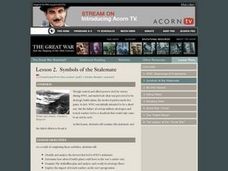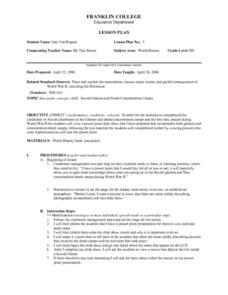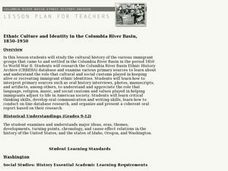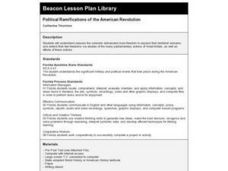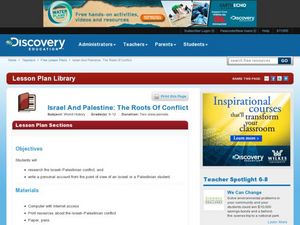Curated OER
Pocumtucks In Deerfield
Students read a story about the Pocumtucks' religious beliefs. Using the text, they discover their concept of land ownership and how they migrated within their territory in different seasons. They use primary and secondary sources to...
Curated OER
American Idealist Lesson 2: Sargent Shriver and Public Service
Pupils explore the public service contributions of Sargent Shriver. In this public service lesson, students explore the work of the Peace Corps and investigate other service learning opportunities.
Curated OER
Saudi Arabia
Students view a video clip about bombings in Saudi Arabia. They discuss the causes and implications of other recent terrorist attacks. They examine the United States - Saudi Arabia relationship as well.
Curated OER
WAR child Canada's: GENOCIDE
Pupils identify reasons genocide occurs through group research into specific Genocide incidents of the 20th century. They put into perspective why an organization such as the United Nations is necessary by introducing them to one of the...
Curated OER
Prelude to War
Students determine that there are many causes of war. They explain that it is hard to remain isolated from world events and review the connection between industrialism and imperialism. They discuss what the consequences might be of...
Curated OER
The Civil War
Eleventh graders study selected prints and/or photos and consider how Americans of the 19th century chose to present themselves to other Americans and the world by means of visual images. They share their observations and opinions.
Curated OER
Lesson 2. Symbols of the Stalemate
Eleventh graders identify and analyze the factors that led to WWI's stalemate. They examine The Schliefflen plan and analyze and rectify its strategic flaws.
Curated OER
The Star-Spangled Banner
Students explore the Star-Spangled Banner. In this civics instructional activity, students read the lyrics of the song as well as a handout that details its creation. Students respond to discussion questions from the handout.
Curated OER
Hiroshima, From All Sides
Students comprehend how the Atomic Bomb affected humanity and ended WWII. They comprehend how the Atomic Bomb affected: scientists, Japanese citizens, and US leaders. Students receive a copy of Hiroshima, Readers Theater Rubiv. They...
Curated OER
Japan's Place In The World
Students conduct research into the history of th Japanese rise to economic power. They use a variety of sources for information and engage in a variety of in class and out of class activities.
Curated OER
Jewish Ghettos and Death/Concentration Camps
Students trace and explain the antecedents, causes, major events, and global consequences of World War II, including the Holocaust. They assess the conditions of Jewish inhabitants of the Ghettos and death/concentration camps and the...
Curated OER
Ethnic Culture and Identity in the Columbia River Basin, 1850-1950
Students explore cultural history of immigrant groups that settled in the Columbia River Basin from 1850 to World War II, and examine various primary sources to explore role cultural and social customs played in keeping alive immigrant...
Curated OER
Scapegoating
Middle schoolers examine how stereotypes, prejudices and discriminatory practices lead to individuals and groups being blamed for events. They are introduced to the internment of Japanese Americans during World War II.
Curated OER
U.S. History: The Second Great Migration
Students examine the migration of rural African Americans to northern cities following World War !!. After predicting the effects of cultural and economic factors, they write essays explaining the impact of migration on communities and...
Curated OER
Numbers Tell a Story
Young scholars connect census data to historical events. In this civics lesson plan, students understand cause and effect, and how they are reflected in census data and analyze census data for social and economic significance.
Curated OER
Modern Movements
Students analyze the art of Jacob Lawrence. For this art analysis lesson, students examine a art from Jacob Lawrence. In this art analysis lesson, students complete image based discussion activities and two related activities.
Curated OER
The Opium Trade, the Opium War and the Treaty of Nanjing
Ninth graders analyze the English model if imperialism with regard to China and examine the economic and political impact of trade and conflict between England and China in the eighteenth and nineteenth centuries. They discuss the...
Curated OER
Fractions: Jewish Population of Europe during WWII
Students evaluate population maps and convert fractions to percentages. In this WWII lesson, students use statistics on the Holocaust to determine population loss and change. Students create their own math questions and answers using the...
Curated OER
Political Ramifications of the American Revolution
Students, in groups, research a topic from the Revolutionary War. They present their research to the class as a review and the instructor summarizes important information. They take a test on the presented topics.
Curated OER
Can't You Make Them Behave, King George?
Fifth graders describe the changes in King George III's policy toward the American colonies by sequencing key events between the French and Indian War and the American Revolution. They explain the colonial reactions to command decisions...
Curated OER
The Russian Years: Back in the USSR
Students examine communist Russia. In this lesson on changes in politics, students work in small groups to compare and contrast soviet communist era citizen rights to those of the US. They participate in discussion of a film and create a...
Curated OER
Israel and Palestine: The Roots of Conflict
Learners examine the causes of the Israeli-Palestinian conflict. In this world conflict lesson plan, students research print and Internet sources about the roots of the conflict and the status of the conflict today. Learners use their...
Curated OER
Allow Me to Demonstrate…
Students examine the causes, actions and results of different demonstrations from around the world in modern history.
Curated OER
Simulating a Middle East Peace Summit
Tenth graders explore the issues in the Middle East. In this World History lesson plan, 10th graders research the problems between Palestine and Israel. Students write a speech on their point of view of the peace process.






